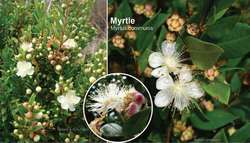and Castanea sativa, the predominant pollens of
Myrtus communis were determined in honey samples from Algeria and Argentina (Costa et al., 1995; Ouchemoukh et al., 2007).
Myrtus communis is an evergreen, bushy shrub or a small tree growing up to 5 meters high with opposite branches and quadrangular cane-shaped, initially delicately glandular, downy branches.13 It grows from the Mediterranean region to the northwestern Himalayas5,13 and is a well-known plant that has been used from ancient times as medication, food preparation and spice.
Cardiovascular and antimicrobial effects of
myrtus communis. Indian J.
Composition and in vitro antifungal activity of essential oils of Erigeron canadensis and
Myrtus communis from France.
[11] compared the healing effects of
Myrtus Communis, Zataria multiflora, Anthemis nobilis, and mixture of Zataria multiflora and Anthemis nobilis on minor RAS.
Holotipo hembra: Mexico, Nayarit, Xalisco, Universidad Autonoma de Nayarit, ex Aleurodicus coccolobae en
Myrtus communis, 18.IX.2012 (col.
Dentro de las formas nectariferas, destaca
Myrtus communis, que con un porcentaje medio de representacion del 78 alcanza el 90% en dos muestras (E2 y E3), y Echium plantagineum, que supero el 20% en la muestra E5 y presento un porcentaje medio del 11% (Fig.
Gul et al., "In vitro enzyme inhibition activities of
Myrtus communis L.," African Journal of Pharmacy and Pharmacology, vol.
Autumn - elaeagnus x ebbingei,
myrtus communis, clematis flammula.
(2006) reported that differences could be for rate of essential oil among populations in
Myrtus communis. Avci and Bayram (2008) emphasized importance of harvesting period and time on essential oil rate in M.
Mae'r enw gwyddonol
Myrtus communis, yn dod o'r gair Groeg 'myrtos' a'i ystyr ydi 'perlysieuyn cariad'.
